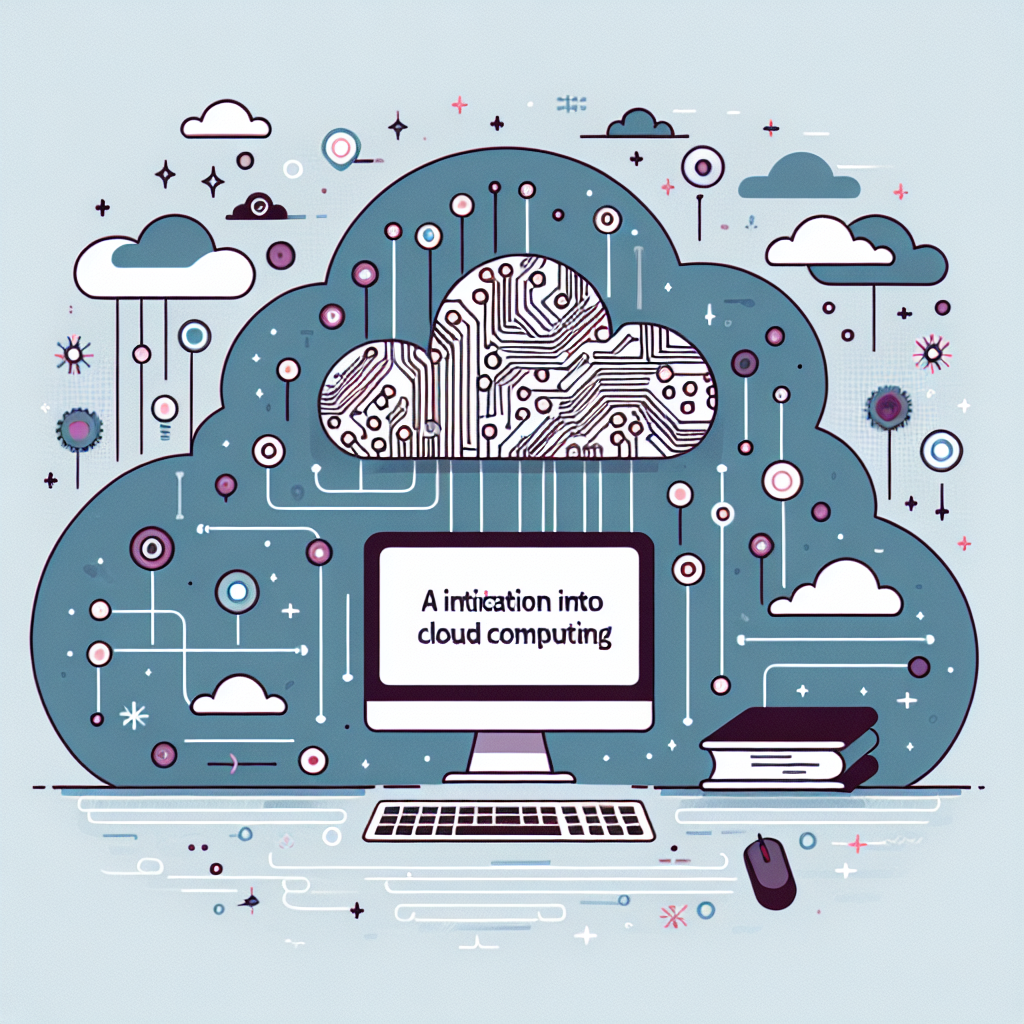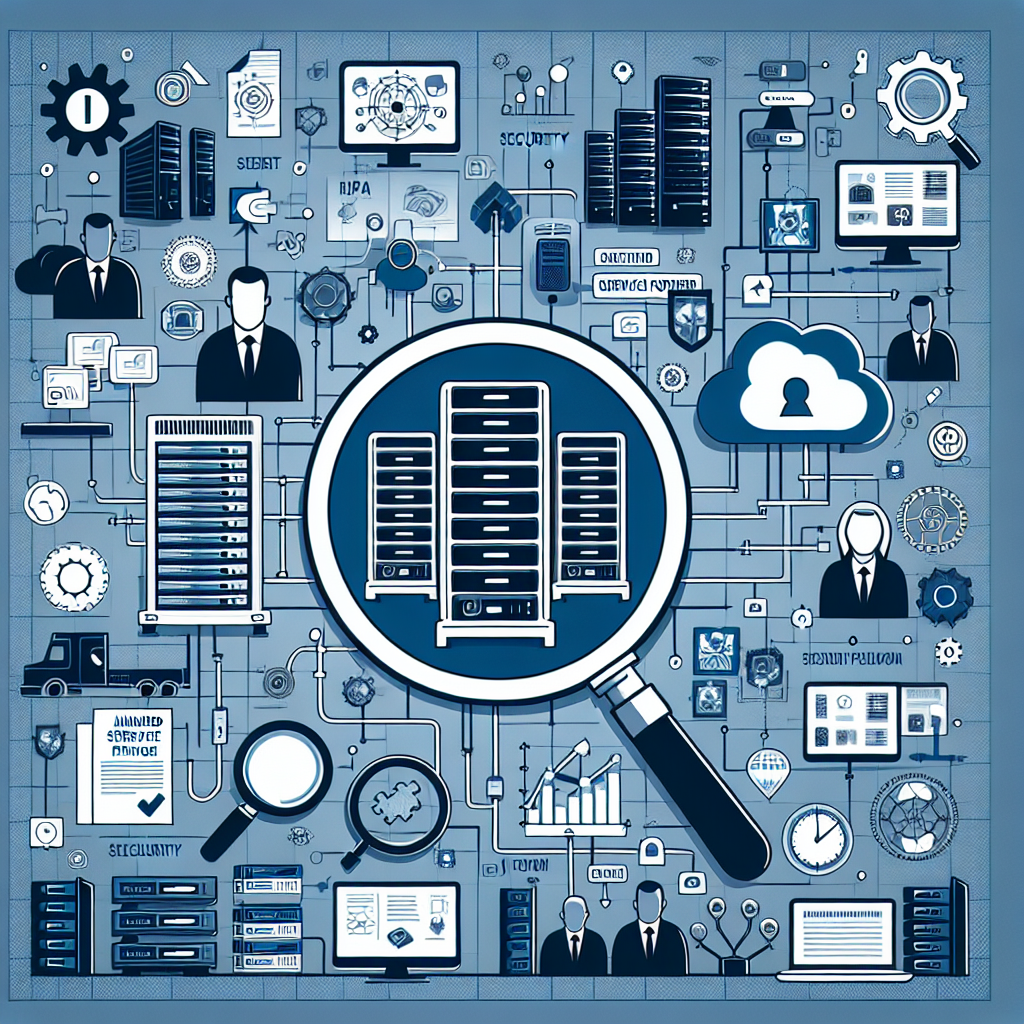Your cart is currently empty!
Tag: Guide

A Guide to Implementing Remote Monitoring Systems in Your Organization
In today’s fast-paced business environment, organizations are constantly looking for ways to improve efficiency, reduce costs, and increase productivity. One way to achieve these goals is by implementing remote monitoring systems in the workplace. Remote monitoring systems allow organizations to keep track of their operations, assets, and processes from anywhere in the world, using a variety of devices such as computers, tablets, and smartphones.Remote monitoring systems can be used in a wide range of industries, including manufacturing, healthcare, energy, and transportation. By providing real-time data on key performance indicators, remote monitoring systems enable organizations to make informed decisions quickly and effectively. They also help organizations identify and address issues before they escalate, leading to reduced downtime and increased profitability.
When implementing a remote monitoring system in your organization, it’s important to consider the following factors:
1. Define your objectives: Before implementing a remote monitoring system, it’s essential to clearly define your objectives and goals. Do you want to improve operational efficiency, reduce maintenance costs, or enhance customer service? By identifying your objectives, you can tailor the remote monitoring system to meet your specific needs.
2. Choose the right technology: There are many remote monitoring systems available on the market, each offering different features and capabilities. It’s important to choose a system that is scalable, user-friendly, and compatible with your existing infrastructure. Consider factors such as data storage, connectivity options, and security features when selecting a remote monitoring system.
3. Train your staff: Implementing a remote monitoring system requires training your staff on how to use the system effectively. Provide comprehensive training sessions to ensure that employees understand how to access and interpret the data provided by the system. This will help maximize the benefits of the remote monitoring system and ensure a smooth implementation process.
4. Monitor and analyze data: Once the remote monitoring system is up and running, it’s important to regularly monitor and analyze the data collected. Use the data to identify trends, patterns, and anomalies that could impact your operations. By analyzing the data, you can proactively address issues and make informed decisions to improve performance.
5. Continuously improve: Implementing a remote monitoring system is an ongoing process that requires continuous improvement. Regularly review the system’s performance and seek feedback from employees to identify areas for enhancement. By continuously improving the system, you can maximize its benefits and stay ahead of the competition.
In conclusion, implementing a remote monitoring system in your organization can provide numerous benefits, including improved efficiency, reduced costs, and increased productivity. By defining your objectives, choosing the right technology, training your staff, monitoring and analyzing data, and continuously improving the system, you can successfully implement a remote monitoring system that meets your organization’s needs.

Getting Started with Cloud Computing: A Beginner’s Guide
Cloud computing has revolutionized the way businesses and individuals store, access, and manage data. Instead of relying on physical hardware and local servers, cloud computing allows users to access resources and services over the internet from anywhere in the world. If you’re new to cloud computing and unsure of where to start, this beginner’s guide will help you understand the basics and get started on your cloud computing journey.1. Understanding Cloud Computing: Before diving into cloud computing, it’s important to understand what it is and how it works. In simple terms, cloud computing involves the delivery of computing services, such as storage, servers, networking, databases, and software, over the internet. These services are provided by cloud service providers, who manage and maintain the infrastructure needed to run these services.
2. Types of Cloud Computing: There are three main types of cloud computing services: Infrastructure as a Service (IaaS), Platform as a Service (PaaS), and Software as a Service (SaaS). IaaS provides virtualized computing resources, such as servers and storage, over the internet. PaaS offers a platform for developers to build, deploy, and manage applications. SaaS allows users to access software applications over the internet, without the need for installation or maintenance.
3. Benefits of Cloud Computing: Cloud computing offers numerous benefits, including cost savings, scalability, flexibility, and improved collaboration. By moving to the cloud, businesses can reduce their IT costs by eliminating the need for physical hardware and on-premises servers. Cloud computing also allows for easy scalability, as users can quickly add or remove resources as needed. Additionally, cloud-based applications can be accessed from any device with an internet connection, enabling remote work and collaboration.
4. Getting Started with Cloud Computing: To get started with cloud computing, you’ll first need to choose a cloud service provider. Some of the leading providers include Amazon Web Services (AWS), Microsoft Azure, and Google Cloud Platform. Each provider offers a range of services and pricing options, so it’s important to research and compare before making a decision.
Once you’ve selected a provider, you can sign up for an account and start exploring the services they offer. Many providers offer free trials or credits for new users, allowing you to test out their services before committing to a paid plan. You can start by creating virtual servers, setting up storage, or deploying applications on the cloud.
5. Best Practices for Cloud Computing: As you navigate your cloud computing journey, it’s important to follow best practices to ensure the security and efficiency of your cloud environment. This includes implementing strong security measures, such as encryption, access controls, and regular backups. It’s also important to monitor your cloud resources and optimize their usage to minimize costs.
In conclusion, cloud computing offers a wealth of opportunities for businesses and individuals looking to streamline their operations and access resources on-demand. By understanding the basics of cloud computing, choosing the right provider, and following best practices, you can make the most of this powerful technology and take your computing to the next level.

Maximizing ROI with Managed Service Providers: A Guide for Small Businesses
In today’s fast-paced business world, small businesses are constantly looking for ways to maximize their return on investment (ROI). One way to do this is by utilizing managed service providers (MSPs) to handle various aspects of their IT infrastructure.MSPs are third-party companies that provide a range of IT services to businesses, including network monitoring, data backup and security, and software management. By outsourcing these tasks to an MSP, small businesses can free up time and resources to focus on core business activities, while also benefiting from the expertise and resources of a dedicated IT team.
But how can small businesses ensure they are getting the most out of their investment in an MSP? Here are some tips for maximizing ROI with managed service providers:
1. Define your goals: Before partnering with an MSP, it’s important to clearly define your business goals and objectives. This will help you determine which services you need from an MSP and how they can help you achieve your goals.
2. Evaluate your current IT infrastructure: Take stock of your current IT systems and processes to identify areas where an MSP could provide value. This could include improving network security, streamlining software updates, or enhancing data backup and recovery processes.
3. Choose the right MSP: When selecting an MSP, it’s important to do your research and choose a provider that aligns with your business needs and goals. Look for an MSP with experience working with small businesses in your industry, and make sure they offer the services you need at a price that fits your budget.
4. Communicate effectively: Building a strong relationship with your MSP is key to maximizing ROI. Keep lines of communication open, provide clear feedback on their services, and work together to address any issues that arise.
5. Monitor performance: Regularly monitor the performance of your MSP to ensure they are delivering on their promises. Keep track of key metrics such as network uptime, response times, and security incidents to gauge the effectiveness of their services.
6. Continuously improve: Work with your MSP to identify areas for improvement and implement changes to optimize your IT infrastructure. By continuously evaluating and refining your partnership with an MSP, you can ensure you are getting the most out of your investment.
Overall, partnering with an MSP can be a cost-effective way for small businesses to enhance their IT capabilities and maximize ROI. By following these tips, small businesses can build a successful partnership with an MSP that helps them achieve their business goals and drive growth.

Choosing the Right Managed Service Provider for Your Company: A Guide
In today’s fast-paced business environment, companies are increasingly turning to Managed Service Providers (MSPs) to handle their IT needs. MSPs offer a wide range of services, from network monitoring and security to data backup and disaster recovery. Choosing the right MSP for your company is crucial, as they will play a key role in ensuring the smooth operation of your business.Here are some key factors to consider when selecting an MSP for your company:
1. Experience and Expertise: Look for an MSP that has a proven track record in providing IT services to companies in your industry. They should have a team of experienced professionals who are experts in their field and are up-to-date on the latest technologies and trends. Check their references and ask for case studies to see how they have helped other businesses.
2. Services Offered: Consider what services your company needs and make sure the MSP offers them. Some common services provided by MSPs include network monitoring, security, data backup, and cloud services. Make sure the MSP can tailor their services to meet your specific needs and can scale as your business grows.
3. Security and Compliance: Data security is a top priority for businesses, especially in industries that handle sensitive information. Ensure the MSP has robust security measures in place to protect your data from cyber threats. They should also be compliant with industry regulations and standards, such as HIPAA for healthcare or GDPR for data protection.
4. Support and Response Times: It’s important to choose an MSP that offers 24/7 support and has a fast response time to address any IT issues that may arise. Make sure they have a dedicated support team that can quickly resolve problems and minimize downtime for your business.
5. Pricing and Contracts: Consider the cost of the MSP’s services and compare them with other providers in the market. Look for a provider that offers flexible pricing options and transparent contracts with no hidden fees. Make sure you understand what is included in the service agreement and what additional costs may apply.
6. Communication and Relationship: A successful partnership with an MSP is built on good communication and a strong relationship. Choose a provider that is responsive to your needs and keeps you informed about the status of your IT systems. They should act as a trusted advisor, offering recommendations for improving your IT infrastructure and helping you achieve your business goals.
In conclusion, choosing the right Managed Service Provider for your company is a critical decision that can have a significant impact on your business operations. By considering factors such as experience, services offered, security, support, pricing, and communication, you can find an MSP that meets your needs and helps your company thrive in today’s competitive business landscape.
Your guide to Kendrick Lamar
Since the first Super Bowl in 1967, the halftime show has always been an attraction for fans during the longest scheduled break in the big game. That first title game featured marching bands from the University of Arizona and Grambling College.
The halftime show remained a showcase of marching bands through the 1980s into the 1990s. But things changed when Michael Jackson performed at the 1993 Super Bowl.
EVERY SUPER BOWL HALFTIME SHOW:Usher was the latest to headline a star-studded list
The pop star’s performance ushered in a new era of halftime shows. Since then, popular artists have been a mainstay for the Super Bowl. The likes of Diana Ross, U2, Janet Jackson, The Rolling Stones, Beyoncé, Madonna and Lady Gaga have all made their mark with a memorable halftime show.
This year’s championship game features the Kansas City Chiefs and Philadelphia Eagles. When these teams met two years ago in Super Bowl 57, Rihanna performed at halftime at State Farm Stadium in Glendale, Ariz.
NFL STATS CENTRAL: The latest NFL scores, schedules, odds, stats and more.
Here’s who will be performing at halftime of this year’s Super Bowl.
Who is doing the Super Bowl halftime show?
Rapper and hip-hop artist Kendrick Lamar is headlining the 2025 Super Bowl halftime show.
This is Lamar’s second appearance during a Super Bowl halftime show. He was a part of the 2022 Super Bowl halftime show alongside fellow rappers Dr. Dre, Snoop Dogg and Eminem as well as Mary J. Blige.
R&B singer SZA will join Lamar during the halftime show as well.
Who is Kendrick Lamar?
Lamar — born Kendrick Lamar Duckworth in Compton, Calif. — is one of the most acclaimed hip hop artists of all-time. He released his debut album titled “Section.80” in 2011 and signed with Aftermath Entertainment (owned by Dr. Dre) and Interscope Records a year later.
His second album “Good Kid, M.A.A.D. City” pushed Lamar into the spotlight. The album went triple platinum and Lamar earned seven Grammy Award nominations, including album of the year.
Lamar’s sold more than 7.5 million albums in the U.S. More than half of that number came from his 2017 album “DAMN.” which sold more than four million copies worldwide. He’s had five albums reach No. 1 on the Billboard 200 chart, most recently his latest album, “GNX,” which was released in November.
Kendrick Lamar awards
Lamar has been nominated for 57 Grammy Awards and have won 17, the third-most by a rapper all-time behind Jay-Z and Kanye West who have 24 each.
His album “DAMN.” was the first musical composition that wasn’t jazz or classical to win the Pulitzer Prize for Music. He was also nominated for an Academy Award for Best Original Song in 2019 for “All the Stars,” a song featuring SZA.
When is the 2025 Super Bowl halftime show?
- Estimated time: 8-8:30 p.m. ET
Because there’s no set duration for the first two quarters of Super Bowl 59, it’s hard to predict with certainty when the halftime show will begin.
Kickoff for the Super Bowl is 6:30 p.m. ET and the first half will likely take an hour and a half, putting the halftime show start time around 8 p.m. ET.
If you’re watching the game strictly for Lamar’s performance, it’d be best to check in around 7:45 p.m. ET just in case the first half goes by unexpectedly fast.
RANKING ALL 58 SUPER BOWLS:How does first Chiefs-Eagles clash rate?
How to watch the 2025 Super Bowl halftime show
- TV channel: Fox
- Streaming:Fubo, Tubi, DirecTV Stream, Sling TV, YouTube TV, Hulu with Live TV
Stream Super Bowl 59 with a Fubo subcription
We occasionally recommend interesting products and services. If you make a purchase by clicking one of the links, we may earn an affiliate fee. USA TODAY Network newsrooms operate independently, and this doesn’t influence our coverage.
Kendrick Lamar is undoubtedly one of the most influential and talented artists in the music industry today. With his thought-provoking lyrics, innovative production, and powerful storytelling, Kendrick has solidified his place as a true icon in hip-hop.If you’re looking to dive into the world of Kendrick Lamar, here’s your ultimate guide to understanding and appreciating his artistry:
1. Start with his albums: Kendrick has released four studio albums, each one showcasing a different side of his artistry. Start with his critically acclaimed debut album, “good kid, m.A.A.d city,” and work your way through “To Pimp a Butterfly,” “untitled unmastered,” and “DAMN.” Each album is a masterpiece in its own right and offers a unique insight into Kendrick’s personal struggles, political beliefs, and social commentary.
2. Pay attention to his lyrics: Kendrick is known for his intricate wordplay, deep storytelling, and socially conscious themes. Take the time to really listen to his lyrics and unpack the messages he is trying to convey. Kendrick’s ability to tackle complex issues such as race, identity, and injustice sets him apart from other artists in the industry.
3. Watch his performances: Kendrick is a dynamic performer who brings his music to life on stage. Check out some of his live performances and see for yourself the energy and passion he brings to his shows. From his powerful delivery to his engaging stage presence, Kendrick knows how to captivate an audience and leave a lasting impression.
4. Explore his collaborations: Kendrick has worked with a wide range of artists across different genres, showcasing his versatility and willingness to push boundaries. From collaborations with fellow rappers like J. Cole and SZA to unexpected pairings with artists like Taylor Swift and Imagine Dragons, Kendrick’s collaborations offer a glimpse into his diverse musical influences.
In conclusion, Kendrick Lamar is a visionary artist who continues to push the boundaries of hip-hop and challenge the status quo. By immersing yourself in his music, lyrics, performances, and collaborations, you can gain a deeper appreciation for his artistry and the impact he has had on the music industry. So, dive in and let Kendrick Lamar take you on a journey unlike any other.
Tags:
- Kendrick Lamar
- Kendrick Lamar guide
- Kendrick Lamar music
- Kendrick Lamar albums
- Kendrick Lamar biography
- Kendrick Lamar discography
- Kendrick Lamar songs
- Kendrick Lamar career
- Kendrick Lamar awards
- Kendrick Lamar achievements
#guide #Kendrick #Lamar

The Importance of Business Continuity Planning: A Guide for Companies
In today’s fast-paced and unpredictable business environment, it is more important than ever for companies to have a solid business continuity plan in place. Business continuity planning is the process of creating a roadmap that outlines how a company will continue to operate during and after a disruptive event, such as a natural disaster, cyber attack, or pandemic.Having a business continuity plan can help companies minimize the impact of disruptions on their operations, employees, customers, and bottom line. By identifying potential risks and developing strategies to mitigate them, companies can ensure that they are prepared to respond quickly and effectively when a crisis strikes.
One of the key benefits of business continuity planning is that it helps companies maintain business continuity and ensure the uninterrupted delivery of products and services to customers. This can help companies maintain their reputation and customer loyalty, even in the face of a crisis.
Business continuity planning also helps companies protect their employees and assets. By having a plan in place, companies can ensure the safety and well-being of their employees during a crisis and minimize the loss of valuable assets.
Moreover, having a business continuity plan can also help companies comply with regulatory requirements and industry standards. Many industries require companies to have a business continuity plan in place to ensure that they can continue to operate in a safe and secure manner.
In addition, having a business continuity plan can help companies save time and money in the long run. By investing in proactive planning and preparation, companies can reduce the costs associated with responding to and recovering from a crisis.
Overall, business continuity planning is an essential component of a company’s risk management strategy. By taking the time to develop a comprehensive plan, companies can ensure that they are prepared to navigate any challenges that come their way and emerge stronger on the other side. It is important for companies of all sizes and industries to prioritize business continuity planning to protect their employees, assets, and reputation in the face of disruptive events.

The Importance of Disaster Recovery Planning: A Comprehensive Guide
In today’s digital age, businesses rely heavily on technology to operate efficiently and effectively. From storing important data to communicating with clients and customers, technology plays a crucial role in the day-to-day operations of any organization. However, with the increasing reliance on technology comes the risk of disasters that can disrupt business operations and cause significant financial losses. This is where disaster recovery planning becomes essential.Disaster recovery planning is the process of creating a strategy to ensure that a business can continue to operate in the event of a disaster, such as a cyberattack, natural disaster, or system failure. This comprehensive guide will outline the importance of disaster recovery planning and provide tips on how to create an effective plan for your business.
One of the main reasons why disaster recovery planning is so important is that it helps businesses minimize downtime and recover quickly from any disruptions. In the event of a disaster, every minute that a business is unable to operate can result in lost revenue and damage to its reputation. By having a solid disaster recovery plan in place, businesses can ensure that they are able to resume operations as quickly as possible and minimize the impact of the disaster on their bottom line.
Additionally, disaster recovery planning helps businesses protect their valuable data and information. In today’s digital world, data is one of the most valuable assets that a business possesses. Losing important data can have serious consequences, including financial losses, legal issues, and damage to the business’s reputation. By creating a disaster recovery plan that includes regular backups and data recovery procedures, businesses can ensure that their data is safe and secure in the event of a disaster.
Furthermore, disaster recovery planning can help businesses comply with regulatory requirements and industry standards. Many industries have specific regulations that require businesses to have a disaster recovery plan in place to protect sensitive data and ensure business continuity. By creating a comprehensive disaster recovery plan, businesses can demonstrate to regulators and stakeholders that they are taking the necessary steps to protect their data and ensure business continuity in the event of a disaster.
So, how can businesses create an effective disaster recovery plan? Here are some tips to get started:
1. Assess the risks: Identify potential threats and vulnerabilities that could disrupt your business operations, such as cyberattacks, natural disasters, and system failures.
2. Define your objectives: Clearly define the goals and objectives of your disaster recovery plan, including the desired recovery time and recovery point objectives.
3. Develop a strategy: Create a detailed plan that outlines the steps to be taken in the event of a disaster, including data backup procedures, recovery procedures, and communication protocols.
4. Test and update your plan: Regularly test your disaster recovery plan to ensure that it is effective and up to date. Make any necessary adjustments based on the results of your tests.
In conclusion, disaster recovery planning is a critical component of any business’s overall risk management strategy. By creating a comprehensive disaster recovery plan, businesses can protect their data, minimize downtime, and ensure business continuity in the event of a disaster. By following the tips outlined in this guide, businesses can create an effective disaster recovery plan that will help them weather any storm.

From Preparation to Response: A Comprehensive Guide to Disaster Recovery
Disasters can strike at any moment, leaving businesses vulnerable and in need of a comprehensive disaster recovery plan. From natural disasters like hurricanes and earthquakes to cybersecurity breaches and data loss, it’s crucial for organizations to be prepared for any eventuality. A well-thought-out disaster recovery plan can mean the difference between a temporary setback and a catastrophic loss.Preparation is key when it comes to disaster recovery. Organizations should start by identifying potential risks and vulnerabilities within their operations. This includes assessing the likelihood of different disaster scenarios and the potential impact they could have on the business. Once risks have been identified, organizations can then develop a plan to mitigate those risks and minimize the impact of a disaster.
One important aspect of disaster recovery planning is data backup and recovery. Organizations should regularly back up critical data and systems to ensure that they can be quickly restored in the event of a disaster. This includes both on-site and off-site backups to protect against physical damage to the primary data storage location.
In addition to data backup, organizations should also have a communication plan in place. This includes establishing a chain of command for decision-making during a disaster, as well as protocols for communicating with employees, customers, and other stakeholders. Clear and timely communication is essential to managing the response to a disaster and minimizing disruptions to business operations.
Once a disaster strikes, organizations must be ready to respond quickly and effectively. This includes activating the disaster recovery plan, mobilizing resources, and implementing contingency measures to ensure business continuity. It’s important for organizations to have designated response teams and designated roles and responsibilities to ensure a coordinated and efficient response.
After the immediate response phase, organizations should conduct a thorough post-disaster assessment to evaluate the effectiveness of their disaster recovery plan and identify areas for improvement. This includes conducting a root cause analysis to determine what went wrong and how similar disasters can be prevented in the future.
Overall, disaster recovery is a critical aspect of business continuity planning. By taking a proactive approach to disaster preparedness and response, organizations can minimize the impact of disasters and ensure that they can quickly recover and resume normal operations. A comprehensive disaster recovery plan should address all potential risks and vulnerabilities, include data backup and recovery protocols, establish clear communication channels, and outline a structured response and recovery process. With the right preparation and response strategies in place, organizations can weather any storm and emerge stronger on the other side.

A Guide to Remote Monitoring: What It Is and How It Works
In today’s fast-paced world, technology has made it possible for us to remotely monitor various aspects of our lives, from our homes to our businesses. Remote monitoring is a form of surveillance that allows us to keep an eye on things even when we are not physically present. In this article, we will explore what remote monitoring is, how it works, and the benefits it can provide.What is Remote Monitoring?
Remote monitoring is a method of monitoring and controlling devices, systems, or processes from a distance. This can include everything from checking the temperature of your home while you are on vacation to monitoring the performance of industrial equipment in real-time. Remote monitoring typically involves the use of sensors, cameras, and other monitoring devices that can transmit data to a central location for analysis.
How Does Remote Monitoring Work?
Remote monitoring works by using sensors or other monitoring devices to collect data on various aspects of a system or environment. This data is then transmitted to a central monitoring station, where it can be analyzed in real-time. Depending on the system being monitored, alerts can be set up to notify users of any abnormalities or issues that may require attention.
For example, in a home security system, sensors can be installed on doors and windows to detect any unauthorized entry. If a sensor is triggered, an alert is sent to the homeowner’s smartphone, allowing them to take action, such as contacting the authorities. Similarly, in a manufacturing plant, sensors can be used to monitor the performance of equipment and detect any potential issues before they escalate into costly downtime.
Benefits of Remote Monitoring
There are numerous benefits to implementing remote monitoring systems, including:
1. Increased Efficiency: Remote monitoring allows for real-time tracking of various parameters, enabling quicker responses to issues and reducing downtime.
2. Cost Savings: By detecting issues early, remote monitoring can prevent costly repairs and equipment failures.
3. Improved Safety: Remote monitoring can help identify potential safety hazards and prevent accidents before they occur.
4. Peace of Mind: Whether you are monitoring your home or your business, remote monitoring provides peace of mind knowing that you can keep an eye on things even when you are not there.
Overall, remote monitoring is a valuable tool that can enhance security, efficiency, and safety in a variety of settings. Whether you are a homeowner looking to protect your property or a business owner seeking to optimize operations, remote monitoring is a powerful tool that can help you achieve your goals.

Choosing the Right MSP for Your IT Needs: A Comprehensive Guide
In today’s digital age, having a reliable and efficient IT infrastructure is crucial for the success of any business. However, managing and maintaining IT systems can be a daunting task, especially for small and medium-sized businesses. This is where Managed Service Providers (MSPs) come in. An MSP is a third-party company that manages and maintains a company’s IT infrastructure, allowing businesses to focus on their core operations.Choosing the right MSP for your IT needs is a crucial decision that can have a significant impact on your business. With the increasing number of MSPs in the market, finding the right one can be overwhelming. In this comprehensive guide, we will provide you with the essential factors to consider when choosing an MSP for your IT needs.
1. Define Your IT Needs: Before you start looking for an MSP, it is essential to define your IT needs and objectives. Identify the specific areas of your IT infrastructure that need to be managed and determine the level of support you require. This will help you narrow down your options and find an MSP that can meet your specific requirements.
2. Experience and Expertise: When choosing an MSP, it is crucial to consider their experience and expertise in managing IT systems. Look for an MSP that has a proven track record of working with businesses similar to yours and has a team of skilled professionals who are knowledgeable in the latest technologies and trends in the industry.
3. Service Level Agreements (SLAs): A Service Level Agreement is a contract between you and the MSP that outlines the services they will provide, the level of support you can expect, and the response times for resolving issues. Make sure to review the SLA carefully and ensure that it aligns with your business needs and expectations.
4. Security and Compliance: Data security is a critical concern for businesses, especially in today’s cyber threat landscape. When choosing an MSP, ensure that they have robust security measures in place to protect your data and systems from cyber threats. Additionally, make sure that the MSP complies with industry regulations and standards to ensure the security and privacy of your data.
5. Scalability and Flexibility: As your business grows, your IT needs will also evolve. Choose an MSP that can scale their services to accommodate your growing business and can adapt to changing technology requirements. Look for an MSP that offers flexible and customizable solutions that can meet your specific needs.
6. Pricing and Cost: While cost should not be the only factor to consider when choosing an MSP, it is essential to understand the pricing structure and ensure that it fits within your budget. Compare pricing plans from different MSPs and consider the value of the services they provide to make an informed decision.
Choosing the right MSP for your IT needs is a crucial decision that can have a significant impact on your business’s success. By considering the factors mentioned above and conducting thorough research, you can find an MSP that can effectively manage and maintain your IT infrastructure, allowing you to focus on your core business operations.

